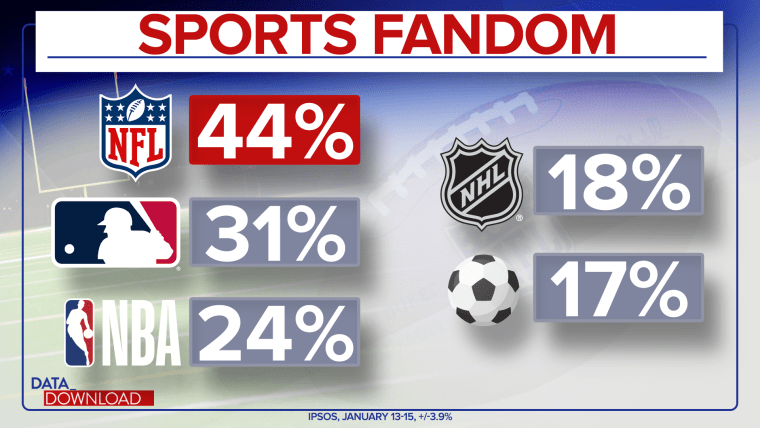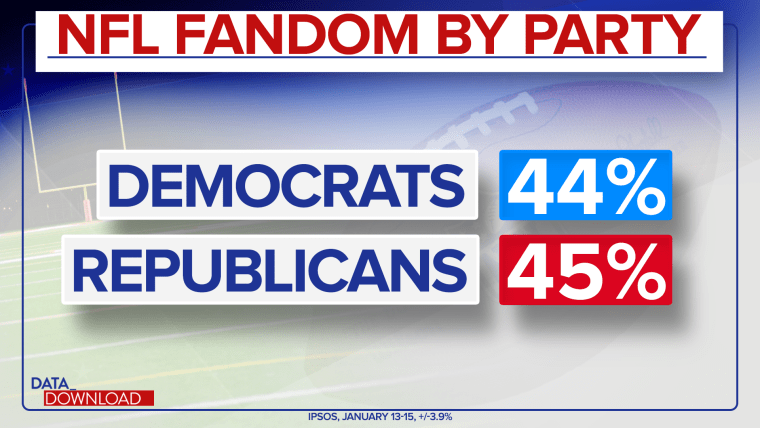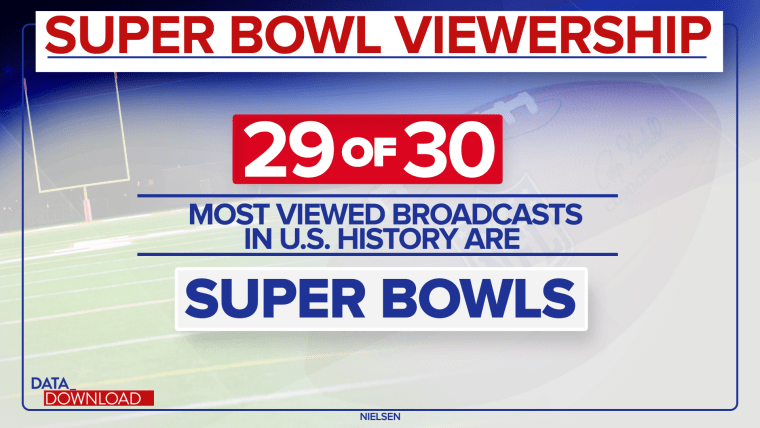WASHINGTON — Commonality is a hard thing to find in the U.S. today. Streaming services and the internet have fragmented how we consume news and entertainment, and the partisan divide in Washington affected where we live to our consumer choices.
Not everything is split down party lines, however, and we can thank the NFL and the annual sporting/cultural event known as the Super Bowl.
Even if you are indifferent to football or actively dislike it, it is hard to argue against the game’s importance as a cultural adhesive for Americans. Its impact can be seen in a wide range of numbers.
The NFL stands above its counterparts in professional baseball, basketball and hockey in terms of people who call themselves fans.

More than 4 in 10 American adults, 44%, say they are fans of the NFL, according to a new poll from Ipsos. That’s 13 points higher than baseball, at 31%, 20 points higher than the NBA, at 24%, and 26 points than hockey, which stands at 18%.
That’s an impressive number for the NFL in a world where a growing number of media outlets and distractions vie for our attention. And, even more impressive in a country where the political red/blue divide seems omnipresent, the NFL seems to float above the fray.

In the Ipsos survey 44% of Democrats said they were fans of the NFL and 45% of Republicans said the same thing — a rare area of partisan common ground.
Furthermore, the lack of partisanship over the league goes back more than a decade, when the partisan wars were less intense. Back in 2007, when the question was phrased slightly differently, 56% of Republicans and 50% of Democrats said they were NFL fans. So even as the country has grown more divided politically, the NFL has been something of an exception.
And all that fandom and bipartisanship have impacts on the bottom line. It makes the NFL a ratings powerhouse — one of the last true shared entertainment experiences in the U.S.
But just how dominant is the NFL? Of the top 100 most-viewed broadcasts in the country last year, 82 were NFL games.

Many of those games are regular season contests drawing 25 million, 26 million and 27 million viewers, according to the site Sportico. For comparison, the premier of the TV show "Yellowstone" was considered a smash hit last year with 16 million viewers.
Capturing 82 of the top 100 broadcast audiences in 2022 is a record for the NFL, but it follows a rising trend over the last few years. In 2021, the NFL had 75 of the top 100 broadcasts. In 2020, it was 69 of the top 100 broadcasts.
That’s not necessarily a ringing endorsement of the league’s product. A big reason the number of NFL slots on the top 100 list continues to grow is media fragmentation everywhere else. Every year there are scores of new streaming dramas, sitcoms and films, but there’s only one NFL that broadcasts games live.
Still, whatever the reason, the NFL is the king of TV viewership when it comes to sheer audience size and impact. And when you look at the Super Bowl, the numbers are almost incomparable.

Of the top 30 most viewed broadcasts in U.S. history, 29 are Super Bowls. On top is the Super Bowl in 2015, with 114 million viewers, but last year’s game clocked in with a respectable 101 million.
The only broadcast in the top 30 that was not a Super Bowl was the finale of "M*A*S*H" in 1983, which garnered an amazing 106 million viewers. That’s enough to place it at No. 9 on the all-time list. And that’s back when the population was only 233 million. Today it's more than 330 million.
To be clear, as good as those viewer and fan numbers are for the NFL, the future for the league isn’t all blue skies. The inherent violence and danger in the game are impossible to ignore.
An NFL player almost died on the field this year, and a Boston University study that looked at the brains of 376 deceased NFL players found that 92% of them suffered from CTE, chronic traumatic encephalopathy. Parents increasingly seem leery of letting their children play football, and at some point fans may turn away.
But as of now, the NFL and the Super Bowl offer something that is in short supply in the U.S., a common experience. In many ways, Sunday’s game represents the last true shared screen in a divided country.